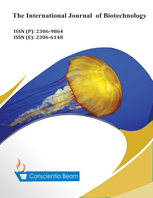Ultrasonic Effect on the Photodegradation of 2,4-Dichlorophenol Wastewater
DOI:
https://doi.org/10.18488/journal.57/2016.5.2/57.2.26.34Abstract
Chlorophenols (CPs) is one of the organic pollutants and are most widespread in aqueous environment. Advanced oxidation processes (AOPs) have been extensively utilized for the decomposition of hazardous or recalcitrant pollutants in the environment. The study combined UV/TiO2 with ultrasonic procedure to degrade 2,4-dichlorophenol (2,4-DCP) wastewater. The effects of factors including pH value, initial concentration of 2,4-DCP and quantities of TiO2, Fe (II), and Fe (III) added on the removal efficiency of 2,4-DCP wastewater were investigated. Experimental results revealed significant additive effect attributed to the combination of two procedures, 13-watt UV irradiation and 10-watt ultrasound, under the pH 10 and 1g L-1 TiO2. In additional, the destruction removal efficiency (DRE) of 2,4-DCP was raised about 10 % when 250 μM of Fe (II) and Fe (III) were added and this phenomenon was suggested that the Fenton-like reaction occurred.

